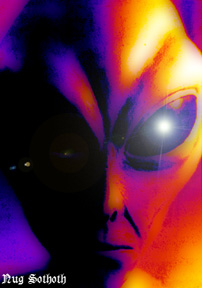|   | 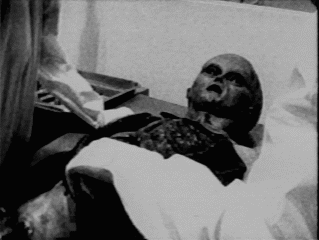 
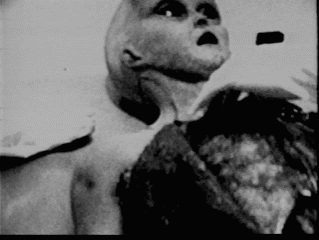
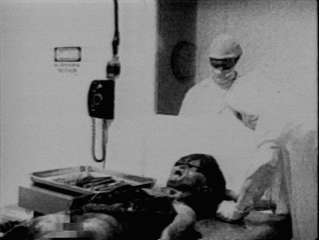
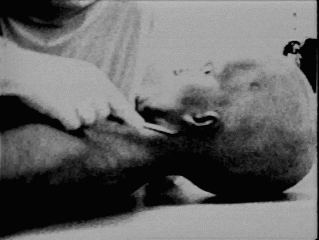
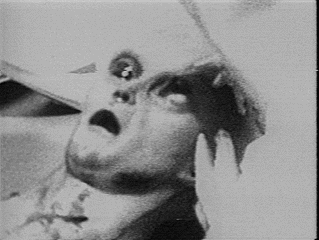
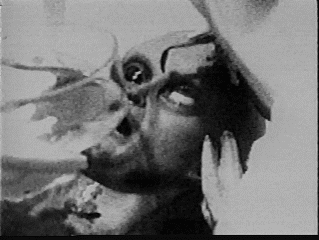
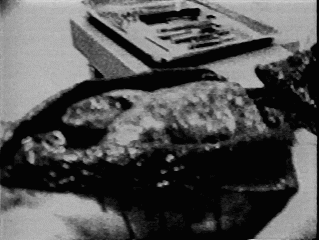
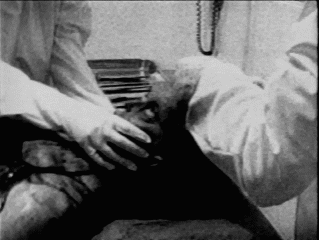
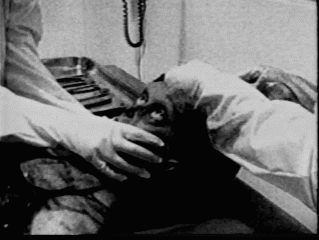
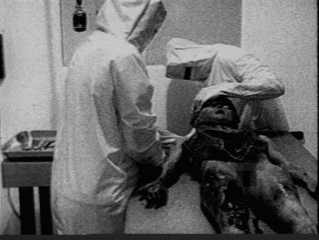
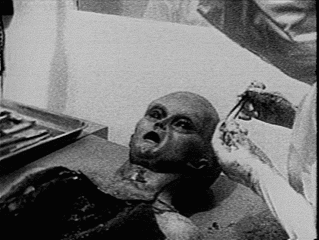
THE 'ROSWELL FOOTAGE' RELEASE
About a year and a half ago, on 5th May
1995, the London-based film producer
Ray Santilli for the first time presented
his alleged alien autopsy footage to an
audience of invited media
representatives and UFO researchers at
the London Museum. Even before that
date, a very emotional debate had
already started. Angry ufologists had
challenged Santilli to shut up or work
together with them, while others had
claimed from the very beginning that the
film is a hoax just because it doesn't fit
into their concept of what happened in
New Mexico in the summer of 1947.
Santilli's marketing policy, his
commercial exploitation of the film, his
ignorance in the UFO field and his
violation of all the unwritten protocols
of the UFO community didn't find many
friends among ufologists, and quite soon
many screamed "Hoax!" without being
able to prove anything. One researcher
even concluded, "There is no [16 mm] film
and no cameraman", after quoting page
after page of all the rumours, second-
and third-hand information and
inconsistencies among Santilli's claims
(or alleged claims), to prove that he was
right from the very beginning when he
suspected a scam, because the being on
the autopsy table looked "too humanoid
to be an extraterrestrial", yet ignoring
that this is exactly how most
eyewitnesses describe crashed
ufonauts.1
Unfortunately, those who searched for
the truth, wherever it might be, were
few in number. Willing to listen to Santilli
first, before they judged and checked
out the information they could get
before asking for more, were mainly
Philip Mantle (UK), Bob Shell (USA) and
Michael Hesemann (Germany)-the
International Research Team (IRT)-joined
by Maurizio Baiata and Roberto Pinotti
(Italy), Johannes Baron of Buttlar
(Germany), Odd-Gunnar Roed (Norway),
Hanspeter Wachter (Switzerland), Col.
Colman VonKeviczky, Dr Bruce
Maccabee, Joe Stefula, Lt. Col. W. C.
Stevens, Ted Loman, Robert Morning
Sky, Llewellyan Wykel and Dennis
Murphy (USA), and others.
Let me point out that we found Ray
Santilli always very friendly, helpful and
cooperative although sometimes limited
in his actions by agreements with his
business partners and the cameraman. I
wonder if any 'major international media
corporation' would ever have been even
nearly as open to any reasonable
research approach as Mr Santilli indeed
was. The following is a summary of
results from the IRT's first year of
investigation.
THE CAMERAMAN
Yes, there is a cameraman. We located
people, besides Santilli, who had spoken
to him over the phone: Gary Shoefield of
Polygram, Philip Mantle, John Purdie of
Channel Four (UK) and the secretary of
David Roehring of Fox Network, USA. He
is American, an old man, and lives in
Florida. He was in hospital when Gary
Shoefield wanted to meet him, and was
coughing when Philip Mantle had him on
the phone. According to his story he had
polio as a child.2 Polio victims at that
time mostly walked with a limp. He could
not have had a bad hand, otherwise he
could not have worked as a cameraman,
but maybe he had a bad leg. The
movement of the cameraman in the film
indicates this, since he doesn't move
smoothly. Bob Shell enquired among
senior US military cameramen if they
could remember a colleague from the
1940s with a bad leg. They knew one. His
name is Jack "X", and he is exactly the
age claimed for the Santilli cameraman:
eighty-six.
The cameraman is not Jack Barnett-a
name used originally by Santilli to
protect the identity of the true
cameraman. Jack Barnett worked for
Universal News, filmed Elvis Presley at a
high-school concert in 1955 and died in
1969. Jack X did not work for Universal,
but filmed Elvis at another concert, an
open-air one, when the Universal
cameramen were on strike.4 The
cameraman agreed to be interviewed by
a major US TV network.
In April 1996 Bob Shell was contacted by
the US Air Force following an enquiry
from President Clinton's scientific
adviser, Dr John Gibbons. The USAF
Captain told Shell that they had located
footage from the same stock in their
archives and verified that at least part
of the Santilli material is genuine, and
shows no dummy and no human. They
knew the cameraman's name-Jack
X-but asked Shell to forward an
address, since the military records
building in St Louis had had a fire and
many records had been lost. A search
would be time-consuming and expensive.
When we asked for details about the
crash site, we became convinced that
the cameraman indeed has an excellent
knowledge of the area in question. With
Ray Santilli as the intermediary-and
Santilli did not know anything about the
area in question and insisted on calling
Socorro "Sorocco"-he even described a
ruined bridge that we could locate only
on our third visit to the area. He knew
exactly what he was talking about.
Although some have criticised the
cameraman's technique in the autopsy
film, other military cameraman think
this is exactly the way they, too, would
have filmed it.
"The cameraman keeps moving to get
out of the way of the surgeon and keeps
trying to get the best perspective. The
job of an army cameraman is to record a
procedure on film, not to deliver
beautiful pictures. And that, here, is an
adequate filmic protocol," said Dr
Roderick Ryan, US Navy cameraman
during the '40s and '50s who filmed
many secret government projects
including the atomic tests on Bikini
Atoll.7
"Among these circumstances, no one
could have made a better job...he was
not only a well-educated and
experienced movie man, but, additionally,
in full knowledge of editing and
production of documentaries. Evidence:
filming the autopsy activities from
various view angles," said Col. Colman
VonKeviczky, who studied at the UFA
Film Academy in Berlin Babelsberg, was
head of the audiovisual division of the
Royal Hungarian General Staff,
cameraman and director of the 3rd US
Army at Heidelberg and member of the
audiovisual department of the United
Nations in New York.8
THE FILM STOCK
Careful study of stills made from the
original film and high-quality Betacam
copies confirmed that the film was
indeed shot on 16-mm material. The
camera handling seen on the autopsy
film indicates the use of a small,
lightweight camera with fixed lenses
(therefore, the out-of-focus close-ups),
like the 16-mm Bell & Howell Filmo
Camera used by US military cameramen
in the '40s-the camera the cameraman
claims he used.9
Leaders of 16 mm film were sent to
Kodak Hollywood, London and
Copenhagen and turned out to bear the
symbols (a square and a triangle) used
by Kodak either in 1947 or in 1967.10
Two segments with three frames each,
one clearly showing the autopsy room,
were given to Bob Shell, editor of
Shutterbug magazine and also a
phototechnical consultant for the FBI and
the US courts. After a careful physical
analysis, Shell confirmed the segments
to be pre-1956 16-mm film. In 1956 Kodak
changed its film-base from
acetate-propionate to triacetate, and
the samples were clearly on
acetate-propionate film. The film type
was Super XX-Panchromatic Safety
Film, a high-speed film used for indoor
filming but which had a life-span of no
more than two years, when cosmic
radiation would cause a 'fogging' of the
material. Shell is sure the film was
exposed and developed within two
years. This, at least, dates the film as
pre-1958.11
THE EQUIPMENT & OBJECTS IN THE
AUTOPSY ROOM
Everything in the film dates to the time
in question. The telephone is an AT&T
model from 1946,12 and spiral cables had
been optional since 1938 and standard
for US Army telephones.13 The wall
clock is a model on the market since
1938,14 and the microphone is a 1946
Sheer Bros mike.15 The table with the
instruments was standard equipment
for a pathologist, as confirmed by Prof.
Cyril Wecht, ex-President of the
American Academy of Forensic
Sciences.16 The bone hammer was not
unusual; nor was the Bunsen burner
which, in autopsies, served the purpose
of burning away body fat.
THE BODY
The corpse on the autopsy table has
been the subject of many disputes as to
whether it is a dummy, a girl with a
genetic disorder or, indeed, an alien.
Nearly all special effects (FX) experts
concluded that it is certainly possible to
fake footage of a realistic-looking
autopsy. There have been many
concerns about 'snuff' movies and the
origin of the corpses used in them. South
America had been named as a possible
origin, but reports from there have
indicated the use of very realistic
dummies. However, no one has found any
evidence of special effects being used in
this autopsy film-although today,
unquestionably, nearly everything can be
faked with the latest state-of-the-art
FX techniques.17
On the other hand, pathologists and
physicians from all over the world who
saw the film were pretty sure the body
was not a dummy, but actually a
corpse-human or humanoid.
It is indisputable that some of the
characteristics of different genetic
disorders can be found in the being on
the autopsy table-mostly disorders such
as Turner's syndrome or progeria,
combined with polydactylism (which is
not a typical element of Turner's
syndrome, although possible in
combination with it) and other
anomalies. This prompted a German
dermatologist, Dr T. Jansen of the
Policlinic of the University of Munich, to
publish a study in a medical journal,
trying to prove that the body is that of a
girl who died from a rare form of
progeria.18 On the other hand, he forgot
to explain why there could be two girls
with identical symptoms including
polydactylism, when progeria is so rare
that there are only 20 cases worldwide.
Unfortunately, the only case of Turner's
syndrome twins, although obviously
documented on film, was never published
in the medical literature.
Indeed, Dr Jansen's 'findings' do not
explain the extreme precautions taken
when the autopsy was performed, i.e.,
why would the team have worn
bio-hazard protection suits if the body
had a genetic disorder, and why would
the being have been fitted with black
eye-lenses? Although Dr Jansen
diagnosed a stroke (common for
progeria patients) as the cause of death,
this does not explain the damaged right
leg, the broken and swollen left leg, the
cut-off right hand and a bruise at the
left temple with a possible bullet wound.
Should we assume that our creature
broke its legs, cut its right hand and
shot a bullet in its head before it died
from a stroke?
More than that, Jansen's explanation for
the missing navel couldn't convince us,
either. To quote Dr Jansen, "It's like if
you put up an umbrella: the unevenness
disappears."19
On the other hand, quite a number of
pathologists concluded that the being
was not human at all, since its inner
organs were like nothing they had ever
seen:
Prof. Christopher Milroy, Home Office
Pathologist, University of Sheffield, UK:
"Although a close-up of the brain was
shown, it was again out of focus.
However, the appearance was not that
of a human brain."20
Prof. Mihatsch, University of Basle,
Switzerland: "As for the organs
removed, they could not be tallied with
any human organs."21
Prof. Cyril Wecht, Ex-President,
American Academy of Forensic Sciences,
USA: "I can't place these structures in
an abdominal context... I find it difficult
to bring in any connection with the
human body as I know it. The structure
that must be the brain, if it were a
human being, does not look like a
brain...it does not seem to be a human
being."22
Dr Carsten Nygren, Oslo, Norway: "This
is not a human brain. It is...much too
dark."23
Prof. Pierluigi Baima Bollone, University
of Turin, Italy: "When we look at the
inner organs of the body we find no
single organ that in any way resembles
any human organ. The main organ, which
could be the liver, has neither the shape
nor the location of a human liver. The
face of the alleged extraterrestrial
shows surprising anatomical features:
very big ocular orbits, a very flat nasal
pyramid, a mouth somehow wide
open...nevertheless, the face is flat,
there is no evidence of facial
musculature which is present in human
beings and is responsible for the large
variety of facial expressions of the
human species... My overall impression is
that we are dealing with a creature that
seems to belong to our species but is so
clearly different from us that it seems
absurd to speculate about the
similarity."
There was not a single physician or
pathologist who, after watching the full
film, concluded it was a hoax or that the
being on the table was a dummy. They all
agreed the corpse was of a living,
biological entity-human or not.
THE PATHOLOGISTS
According to the cameraman the
autopsy was performed by "Dr Bronk"
and "Dr Williams".
Prof. Dr Detlev Bronk (1897-1975) was
no surprise, since his name already
appeared in the controversial "Majestic
12" documents. He was Chairman of the
National Research Council, America's
leading biophysicist and a member of the
Advisory Committee of the Army, Air
Force and of the Atomic Energy
Commission-certainly a person to whom
the supervision of an autopsy of this
relevance could have been entrusted.
After his death, all his papers and
documents were preserved at the
Rockefeller Institute for Medical
Research, of which he was President
from 1953.
Dr Bronk was a very methodical person,
kept detailed diaries and all his
correspondence, notes and dates. But
when Bob Shell wanted to look through
his papers and diaries for 1947, he
learnt that, mysteriously enough, this is
the only year for which all the records
are missing. None of the friendly
librarians could tell him what had
happened to them or why they are still
missing.
Dr Williams might have been Dr Robert
Parvin Williams (1891-1967), who was
Special Assistant to the Surgeon General
of the Army at Fort Monroe, Virginia. He
was a Lt. Col. in 1947 and was promoted
to Brig. General in 1949.Alone, the naming
of Dr Williams-who was the right man in
the right place for the task-indicates
the cameraman had some inside
knowledge.
Were the protagonists of the alien
autopsy footage indeed pathologists or
surgeons-or just actors? We asked the
physicians who viewed the footage:
Prof. Dr Ch. Milroy, University of
Sheffield, UK: "Whilst the examination
had features of a medically conducted
examination, aspects suggest it was not
conducted by an experienced
pathologist, but rather by a surgeon."
Prof. Dr M. J. Mihatsch, University of
Basle, Switzerland: "I do not question
the capability of the pathologist or
surgeon who is working on the corpse."
Prof. Cyril Wecht, American Academy of
Forensic Sciences, USA: "(They) are
either pathologists or surgeons who
have performed a number of autopsies
before."
Prof. Pierluigi Baima Bollone, University
of Turin, Italy: "Definitely surgeons, not
pathologists...well-experienced."
Prof. Jean Pierre, University of Paris,
France: "The persons who performed
the autopsy were certainly of the
medical profession, if not experienced
pathologists."
Dr Carsten Nygren, Oslo, Norway:
"These were surgeons doing the work,
not pathologists."33
In fact, neither Prof. Bronk nor Dr
Williams were pathologists: Bronk was a
biophysicist and Williams a surgeon.
Indeed, not one physician concluded they
were actors or made any mistakes.
One point of criticism was the type of
autopsy performed. Obviously it served
the purpose of determining the cause of
death rather than of learning more
about an alien life-form. On the other
hand, this is explainable by the
circumstances under which the autopsy
was performed.
According to the cameraman, four living
aliens were found at the crash site. One
did not survive the recovery operation,
the second and third died about four
weeks later, and the fourth survived
until May 1949.
We do not know anything about the
autopsy of the first creature, and it
might very well have been that it was
subjected to a 'big' scientific autopsy.
The cameraman filmed the second and
third autopsies on 1st and 3rd July 1947,
when the main concern might have been
to find out the cause of their sudden
deaths in order to find a way to keep
alien no. 4 alive-unless they could
establish communication and find out
why these visitors had come to Earth.
This was surely of a higher interest for
the national defence forces than a
scientific study of an alien life-form.
Nevertheless, we assume that organs
were taken for further study during the
dissection.
Furthermore, according to the
cameraman, the fourth alien was
autopsied scientifically in a medical
theatre in Washington, DC, in the
presence of leading scientists from the
US, England and France.34
THE DEBRIS FOOTAGE
The Santilli footage showing metal
samples was analysed by Dennis W.
Murphy, who has an Academy of Science
degree in marine diving technology and
welding and has studied all types of
metalwork.
He concluded: "I have never seen
anything that resembles the
manufacturing techniques used in the
construction of the I-beams in the
Santilli debris footage. I know of no
manufacturing process that could
produce the multitude of details found on
the I-beams."
Murphy refused possibilities like milling
("When I look at the lettering I see
precise rounds as part of the symbols. I
do not think that you can do this with
current milling machines..."), extrusion,
rolling, casting, moulding ("against
moulding...the apparent lack of weight
for all the pieces..., the acute
right-angles at the roots, the thinness of
the flanges of the I-beam and the finely
detailed definition of the raised
symbols...", which could only be
produced with metal of a high density
which is much heavier than the indicated
weight), and the use of foam-core
paperboard ("the crystalline nature of
the break in the broken beams, the
reflectivity of the material in the break,
the rigidity of the I-beams..." argue
against this possibility, according to
Murphy).
The nature of fractures, the flexible,
light and highly reflective appearance of
the I-beams baffled Murphy and brought
him to the conclusion that, indeed, metal
with an extremely fine, crystalline
structure had been used, manufactured
with an unknown technique.The same
conclusion was drawn by Prof. Dr
Malanga of the University of Pisa,
Italy.36
Master Sergeant Bob Allen, USAF
security coordinator at a top-secret
research facility near Tonapah, Nevada,
recognised the panels on the film: "The
army came, after many years, to the
conclusion that the beings had taken the
boxes out with them because they were
waiting to be picked up. Each panel was
constructed for each of the ETs
individually. They could be fitted into
slots in various apparatus. The entire
system-propulsion, navigation,
everything-could be started and
controlled by these panels. We tried it
too, but our brain frequency was not
fast enough to operate them." According
to Allen, they were presented, together
with other "alien hardware", every 10
years to the Lawrence Livermore
Laboratories for examination as the
basis of latest state-of-the-art science.
This was confirmed by a USAF engineer,
working for Sandia Laboratories in
Albuquerque, who identified them as
some kind of "biofeedback computers
responding to neural impulses".38 "We
learned how to feed information into
them, but we were not able to get
information out of them," he added.
Bill Uhouse, a mechanical design engineer
who worked at the top-secret facility
at Area 51 on the Nevada test
site-where he allegedly worked with
alien technology-identified them as
"personal control panels. They served to
communicate with the individual member
of the crew and possibly to interact
with a computer on board or, better, the
steering unit. When the craft crashed,
each crew member took his panel with
him. Possibly they served as
communication with a mother ship,
which could locate and rescue them."
THE HIEROGLYPHS
When I first saw the hieroglyphs on the
I-beams, I immediately recognised a
similarity with the Greek and Phoenician
alphabets. Indeed, both of them have a
common origin and belong to the same
'family' as the many different Semitic
alphabets-Aramaic, Sabaeic, Samaritan,
Hebrew, Protocanaanitic, Nabataeic and
Arabic-which all originate from the
hieroglyphic alphabet, one of the four
main groups of Egyptian hieroglyphs (the
others being two- and three-syllable
signs and ideograms).40
Interestingly enough, inscriptions which
clearly belong to the same family of
alphabets, but pre-date the Phoenician or
even the Egyptian culture, have been
found all over the world-in Peru (Ylo),41
Ecuador (Cuenca),42 Brazil (Piedra
Pintada),43 France (Glozel, Maz
d'Azil),44 on the Canary Islands,45 and
elsewhere. Because of their similarity
with the Phoenician alphabet, I call them
"Proto-Phoenician".
In this context I was able to decipher
both I-beams and translate their
inscriptions using languages from the
same context and language families as
the alphabets. They say: "DIREQH
ELE/ECE" and "OSNI". "DIREQH" is related
to the Hebrew "Derekh", meaning "way,
path, journey". "ELE" could be a plural of
"El", meaning "God", like the Hebrew
"Elohim", and "ECE" is related to the
Egyptian "ase", meaning "to introduce"
or "to approach". So, depending on
whether we read the second sign as a
"lambda/lamed" or a "gamma/gimel",
we can translate it alternatively (since
we don't know the grammar) as "the
journey of the gods", a prayer, like "Go
with God", or "a journey to approach/
introduce". I translate "OSNI" as the
Egyptian "asni", meaning "to make to
open",46 either philosophically, as in "to
open for a contact" or "to open the
consciousness", or, in a practical sense,
as in "Open here".
But why would extraterrestrials speak
and write like Phoenician, Hebrew or
Egyptian? Maybe because it's the
language of the gods, who introduced it
on Earth. In fact, the ancient Egyptians
believed their hieroglyphic system had
been brought to them by Thoth or Tehuti,
the God of Wisdom, one of the Neteru
("Watchers") who travelled in the
celestial barks on the celestial Nile-the
Milky Way.47
Is it a coincidence that the mathematical
system of both ancient Sumer and Egypt
was based on 12, when here we meet
beings with 12 fingers? We find
twelve-toed footprints on Anasazi
petroglyphs in the Canyonlands of Utah,
USA,48 and a twelve-fingered Sky
Kachina in the tradition of the Laguna,
Hopi and other Pueblo Indians.49 The
Brazilian Ugha Mongulala believe their
"Ancient Fathers", who came from the
stars, had "six fingers and six toes as
signs of their divine origin".50
ROSWELL OR SOCORRO?
Ray Santilli's claim that the film was
"the Roswell footage" caused a lot of
controversy, since none of the
witnesses to the July 1947 UFO
crash/retrieval event had confirmed
either the bodies or the debris. Indeed,
the corpses found in Roswell were
smaller, more slender, and had four or
five fingers, according to
eyewitnesses.51 None ever mentioned
six fingers. In any case, if the film were
a fake, why did those responsible for it
not care to read at least one of the
many books on this subject or see the
excellent TV mini-series, Roswell, by
Paul Davies, as shown on Showtime?
The very first information I got from
Santilli about the source of the film made
me wonder if it actually had anything to
do with Roswell at all. Ray already
insisted on 5th May 1995 that the
autopsies had been filmed on 1st and 2nd
July 1947, and that the recovery had
taken place "in the beginning of
June"-one month too early for Roswell.
When I went to Roswell on 30th June
1995 to confront the eyewitnesses
(including Robert Shirkey, Glenn Dennis
and Frank Kaufmann) with the
just-released stills from the film, I asked
Santilli for details about the crash site.
He could only tell me it was "about
four-and-a-half hours away", "close to
White Sands test site" and "an Apache
reservation", and "at the northern
shore of a small dry lake at the end of a
small canyon". I asked him to call the
cameraman to obtain more detailed
instructions, which, indeed, he did. He
said the crash site was "between
Socorro" (Ray said "Sorocco") "and
Magdalena".
By the end of July 1995, Santilli released
the full story of the cameraman who
confirmed he had learnt of the crash on
1st June 1947-which dates the event
back to the late hours of 31st May 1947.
Date, location and everything we see on
the film didn't fit with Roswell.
Conclusion: it was a different event.
The fact that the cameraman had been
flown into Roswell and brought to the
crash site by car, caused him to believe
he'd been involved in "the Roswell
incident" that he'd heard about-and
Santilli believed him.
THE CRASH/RETRIEVAL SITE
Following the instructions given by the
cameraman, I was able to find the small
dry lake at the end of a canyon by
following "the last dirt road before the
(Magdalena) mountains". It was about 15
miles away from the White Sands
Proving Grounds and the Bosque del
Apache National Wildlife Resort, a
former reservation.
On the third visit to the site, Ted Loman
was even able to find the ruins of a
(railway) bridge mentioned by the
cameraman. After we sent photographs
to the cameraman, he was able to
confirm the site.
In September 1995 Santilli released the
cameraman's drawings, enhanced by a
graphic artist, showing the crash scene.
Although the scenery in our photographs
looked different, we found that, coming
from the canyon, it looked exactly like it
was in his drawings. Right where he
drew the craft crashed into a cliff, we
found an area, 20 metres in diameter,
where someone had deliberately sizzled
off the rock as if trying to remove
traces.
Above the dry lake bed we located an
old mine. According to the New Mexico
Office of Mining & Technology in Socorro
it was a manganese mine, called
"Niggerhead Mine", which was closed in
1938, reopened during the war when
manganese was precious and needed,
and closed down again in 1945. According
to the cameraman, it was again
reopened by the US Government
(Department of the Interior), but with no
further mining, on the very day the
retrieval began: 1st June 1947.52 Mining
operations were used as cover events
for the Manhattan Project and maybe
also here. Isn't the reopening of a mine a
perfect excuse for moving in heavy
equipment-cranes, flatbed trucks-and
personnel, and cordoning off of an area?
An Air Accident Report, allegedly
written by General Nathan Twining of
the Air Materiel Command at Wright
Field and published by the late Len
Stringfield, mentions a "Flying Disc
Aircraft found near White Sands Proving
Grounds" at some time before 16th July
1947, the date of the report. Since the
report covers the full technical
evaluation of the craft, we can assume
the crash happened at least one month
beforehand, if not more.53
Stringfield quoted another witness,
Major V. A. Postleweith of US Army
Intelligence, who had seen a classified
telex mentioning a disc crash "in the
vicinity of the White Sands Proving
Grounds".54
CRASH AND RETRIEVAL WITNESSES
We located several witnesses to a
'crash' that very day in question: 31st
May 1947, in the evening hours. Fred
Strozzi, a local rancher who lived just a
few miles away from the crash site,
claimed to have seen a meteorite
"bigger than a basketball" falling during
that time and in the area in question,
according to Betty and Smoky Pound,
another local rancher couple.55
Unfortunately, Strozzi passed away
years ago, so we couldn't ask him for
details.
But the same 'meteorite' had also been
seen by a group of Native American
children of the Acoma tribe who went to
school in Gallup, New Mexico. That day,
31st May-which one of them
remembered quite clearly because it
was just before her birthday-was a
very hot day, so they played in the
evening when it had cooled down.
"Suddenly the whole sky was lit up as if
it was daytime," one of them recalled.
"In less than four seconds, a big ball of
fire glided silently over our heads from
left to right, i.e., northwest to
southeast"-which is the direction of
Socorro. "The light was so bright that
we kids held our hands before our faces
to protect our eyes."
Two days later, most of the children had
blisters on their hands and
arms-"itchies" as they called them. We
received a letter from the daughter of
one of the witnesses and interviewed
two others, one on the phone, the other
on camera.57 A meteorite wouldn't
cause blistering like this. According to
the cameraman, when he moved in about
24 hours later, the crashed disc was
still hot and there was the danger of a
fire, so we can indeed assume that the
craft was a 'fireball' when it crashed in
the late hours of 31st May 1947.
Did the local newspapers cover the
'meteorite' sighting? Ted Loman tried to
find out, and visited the office of the
Socorro Chieftain. He was told that in
the late 1960s a fire destroyed some of
the papers and that, in fact, some were
missing-those between 10th May and
15th June 1947. At the suggestion of the
editorial assistant he spoke to, Ted tried
at the library of the local mining
university, where he found microfilms of
all the issues of the paper-with the
exception of those between 10th May
and 15th June 1947. His attempt to find
them in the Rio Grande Collection of the
New Mexico State University at Las
Cruces, New Mexico, was also
unsuccessful.
Bob Shell tried at the neighbouring town
of Magdalena. Again, all papers from that
period were missing. He was told, "You
won't find them. I have been looking for
them for years and nobody has them."
He also tried at the Zimmerman Library
of New Mexico, without success.
According to the cameraman, the craft
was delivered on the back of a flatbed
truck to Wright Field, Ohio, by the middle
of June 1947. A witness, Howard
Marston, a civilian engineer who worked
at a testing laboratory at Wright Field in
the summer of 1947, claims he was
present "when they brought in a disc...
It was on the trailer of a truck, covered
with tarpaulins. They unloaded it in a
hangar. I saw it from a distance when
they uncovered it. It was a metallic disc,
about 30 to 40 feet in diameter,"
Marston told me when I interviewed
him.58
WITNESSES TO THE FILM'S ORIGIN
We located four eyewitnesses who had
seen footage from the same stock as
the Santilli film in the possession of the
US military and intelligence-a fact
recently confirmed by USAF Capt. John
McAndrews.59
Master Sgt Bob Allen was security
coordinator at a top-secret test site
near Tonapah, Nevada. When he was
briefed for his work, he was shown
films for about two-and-a-half hours.
When he saw the Santilli film on TV he
immediately recognised them as part of
the same stock. "I saw three
autopsies," he told me. "During one,
Truman stood behind the glass screen in
the autopsy room. He wore a surgeon's
face-mask, but one could see it was
Truman. After a few days the first one
died, then the second. They said, 'Damn,
they are dying like flies and we have to
find out if they have any hostile
intentions and what they are doing here.
We must find a way to keep the fourth
alive.' That's why the autopsies were
done. The fourth extraterrestrial lived
for another two years..."60
Sgt Clifford Stone, US Army, was
stationed at Fort Ley, Virginia, in 1969.
He was part of a
Nuclear/Biological/Chemical Accident
(NBC) Quick Reaction Team. He said, "My
mission on that was to be the NBC NCO,
the communications NCO. I had the
opportunity to take our Lieutenant to
Fort Belvoir, Virginia. At Fort Belvoir,
myself and another person, a person
from the Air Force, an airman, went to
gallivant around and went up the stairs
in an auditorium there, and we went into
one room and sat down, and there was
this plexiglass window down into the
theatre...and they were watching down
there what we believed to be trailers of
science-fiction movies.
"There were these common
saucer-shaped UFOs, cigar-shaped
UFOs...and you also had bodies. The
airman and I went ahead and tried to
figure out what movies these came from
because we had an interest in SF... There
were several types of bodies... When we
did this, some people came in and told us
to follow, in no uncertain terms." Both
were arrested and underwent an
"intensified debriefing" which took four
nights and five days. "When I saw the
Santilli tape, I saw the pictures first:
they were haunting, because they took
me back to this day in 1969, to these
movies that they were watching. There
were bodies that looked very, very,
very close to that one. And there were
alive ones, also. I have knowledge that
there is footage within a tent. I have
knowledge of a film with-if that is not
Truman in the film, it is a very
convincing double."61
On 26th June 1995, the British
researcher Colin Andrews visited Ray
Santilli in the presence of the Japanese
researcher Johsen Takano, who advises
the Japanese Government in UFO
matters, and Dr Hoang-Yung Chiang of
the National Research Centre for
Biotechnology in Taipeh, Taiwan. Dr
Hoang-Yung teaches at the Cultural
University and the Medical University of
Taipeh and, through his initiative, ufology
is now officially recognised by the
Taiwanese Government as a scientific
discipline.
After a private viewing, both Takano and
Hoang-Yung told Andrews they had seen
the film before: Johsen, when his
government had requested UFO
information from the US Government,
which was then brought to Tokyo by a
CIA courier; Hoang-Yung, when he had
visited the CIA's headquarters in
Langley, Virginia.62
CONCLUSION
While nobody has been able to present
any proof that the Santilli autopsy
footage was faked, we have some
convincing indications that the film might
very well be genuine. If it is a hoax, it is
definitely the most ingenious fake of the
century.
Instead of continuing the polemic of the
last year or so, serious UFO
researchers should continue to evaluate
the evidence and search for the truth, in
what might turn out to be the most
provocative proof yet that we are not
alone in the Universe.
|
